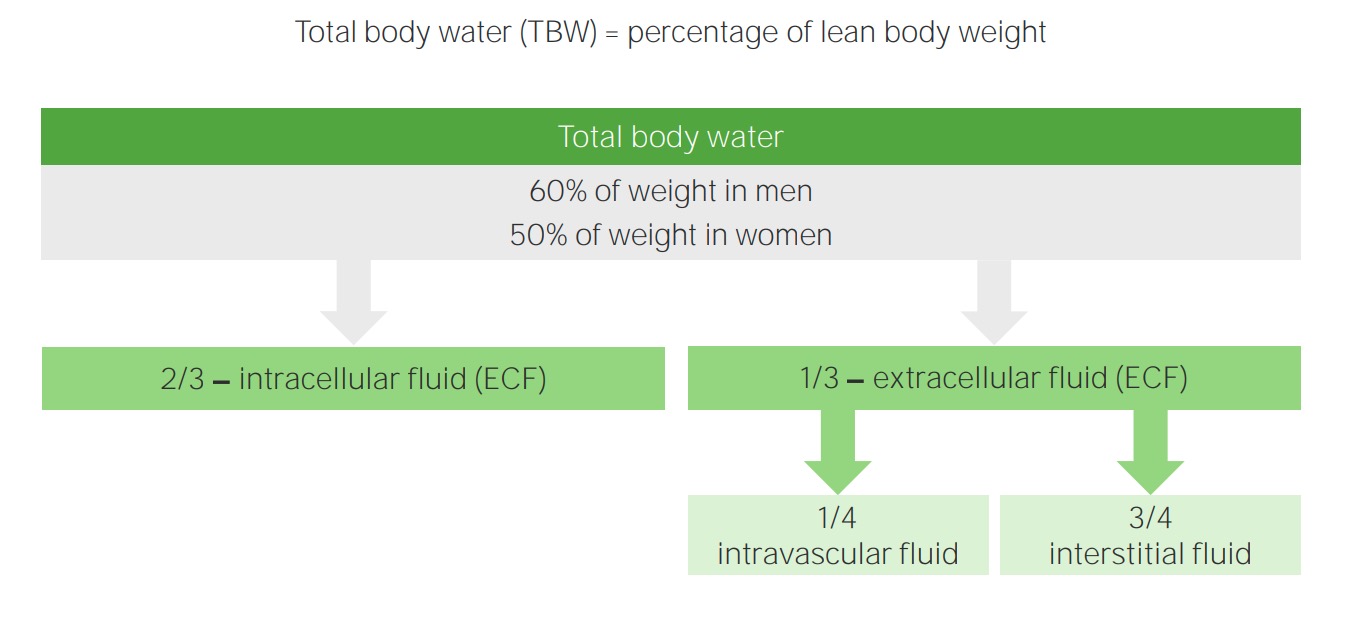Playlist
Show Playlist
Hide Playlist
Body Water Balance: Normal Kidney Function
-
Slides Water Balance Hypo and Hypernatremia.pdf
-
Download Lecture Overview
00:01 Let's take a tour through our nephrons, so that we can understand exactly how water is handled. 00:06 So, if we start at our proximal tubule, the proximal tubule reclaims most of the water, and electrolytes that's filtered through the glomerular basement membrane. 00:15 So, in the tubular fluid, right there at the proximal tubule, our tubular fluid is going to be iso-osmotic to our plasma osmolality. 00:24 Once we get to the thicky ascending limb of the loop of Henle remember what's there, that's the NKCC2. 00:30 We are going to reabsorb sodium, potassium, and chloride and that helps to generate our osmotic gradient in the medulla associated with the vasa recta. 00:39 But remember, that also that segment is impermeable to water. 00:43 So it's what we refer to as our diluting segment. 00:48 The next segment to pay attention to is the distal convoluted tubule, an early collecting duct. 00:53 Which will again, reabsorb more sodium chloride that sodium chloride cotransporter, and impermeable to water. 00:59 So it generates a very diluted tubular fluid or urine at the top of the collecting duct. 01:06 Once we get at the collecting duct, then the ultimate concentration of urine is really going to be determined by whether or not we have ADH present. 01:17 Now, ADH stands for antidiuretic hormone, it's also termed vasopressin. 01:22 We're going to be talking a little bit more about that in some slides to come. 01:26 So what happens when we have an acute water load or need to excrete free water? We can accomplish this by reducing our urine osmolality to as low as 50 to 75 mOsmol/L. 01:38 But it requires normal renal function to do that. 01:41 Meaning that a couple of things have to be true. 01:44 Number one, we have to have delivery of solute and water to those diluting sites. 01:49 So if that's compromised by things like renal failure, for example, or volume depletion, where we don't have appropriate solute delivery to those sites that can impact our ability to actually get that urino some down as low as possible. 02:05 We also have to have proper functioning of the diluting segments. 02:09 Again, this can be compromised by people who are taking diuretics. 02:13 Things that block that Na-K- 2 Cl cotransporter like loop diuretics and the thicky ascending limb of the loop of Henle can really impair our ability to get our urine dilute as possible to excrete that free water load. 02:28 ADH also has to be absent at that collecting duct. 02:32 Meaning that it has to be impermeable to water. 02:34 So if ADH is present, remember what's going to happen is it's going to cause reabsorption of water by insertion of aquaporin channels into that collecting duct. 02:43 So, again, in order for us to make a dilute urine, we have to have solute delivery, we have to have those diluting segments open, and we have to make sure that ADH is suppressed. 02:58 Now, what if we want to retain significant free water? We can actually do that by concentrating our urine osmolality to as high as 1000 or 1200 mOsmol/liter. 03:10 And we can do this by developing a concentrated medullary interstitium by solute reabsorption in the thick ascending limb. 03:16 Again, that thicky ascending limb, and that diluting segment has to be intact in order to reabsorb sodium to generate that concentrated medullary interstitium. 03:26 We also have to have the presence of ADH. 03:28 ADH has to be released and present in order to stimulate the insertion of aquaporin channels into the apical membranes of our collecting ducts cells. 03:37 Not only does it have to be present, the ability of the collecting duct cells to respond to the ADH by inserting those aquaporin channels has to be intact as well. 03:45 So these three things are critical in order to maintain or generate a very concentrated urine.
About the Lecture
The lecture Body Water Balance: Normal Kidney Function by Amy Sussman, MD is from the course Water Balance: Hypo- and Hypernatremia.
Included Quiz Questions
Which of the following is expected in response to water deprivation?
- Increased NaCl reabsorption in the thick ascending limb
- Decreased water permeability in the collecting duct
- Inhibited osmoreceptors in the hypothalamus
- Decreased urine osmolality
- Decreased feeling of thirst
Loop diuretics exert their effects at which part of the nephron?
- Thick ascending limb of the loop of Henle
- Distal convoluted tubule
- Proximal convoluted tubule
- ADH receptor
- Collecting ducts
Customer reviews
5,0 of 5 stars
| 5 Stars |
|
5 |
| 4 Stars |
|
0 |
| 3 Stars |
|
0 |
| 2 Stars |
|
0 |
| 1 Star |
|
0 |




